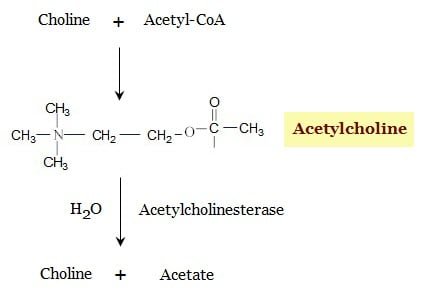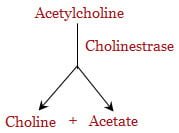Cholinergic neurotransmission
Acetylcholine is the Cholinergic neurotransmission substance at the parasympathetic neuroeffector junctions, autonomic ganglia, adrenal medulla, somatic myoneural junctions and probably in certain CNS regions. Neurohumoral transmission processes seem to be basically quite similar at all cholinergic junctions.
Synthesis of acetylcholine
Acetylcholine is synthesized locally in the cholinergic nerve endings by the following pathway-

Choline is actively taken up by the axonal membrane and acetylated with the help of ATP and coenzyme-A by the enzyme choline acetylase present in the axoplasm. Uptake of choline is the rate limiting step. This uptake is blocked by Hemicholinium and depletes acetylcholine.
Storage of acetylcholine
Most of the acetylcholine is stored in ionic solution within small synaptic vesicles. But some free acetylcholine is also present in the cytoplasm of cholinergic terminals. Transport of acetylcholine into the synaptic vesicles is blocked by the drug vesamicol.
Depolarization permits the influx of Ca++. this Ca++ facilitates the fusion of axonal and vesicular members at active zones resulting in extrusion of the contents. Ca++ ionophores can also stimulate release of acetylcholine. Mg ++ inhibits the release of acetylcholine.
Release of acetylcholine from the nerve terminals occurs in small quanta – amount contained in individual vesicles is extruded by exocytosis. In response to a nerve action potential, synchronous release of multiple quanta triggers postjunctional events.
Note
Two toxins, Botulinum toxin inhibits release of acetyl choline and causes paralysis. Black widow spider venom induces massive release of acetyl choline
Destruction of acetylcholine
Immediately after release, acetylcholine is hydrolyzed by the enzyme cholinesterase-

It is stated that acetylcholine is removed in a flash like suddenness. Hydrolysis of acetylcholine produces choline and acetate. Choline is actively taken up into the prejunctional nerve cell and recycled. There are two types of acetylcholinesterases viz., True and Pseudo acetylcholinesterases.
True and Pseudo acetylcholinesterases
| True Cholinesterase | Pseudo Cholinesterase | |
| Distribution | All cholinergic nerve sites, RBC, gray matter | Plasma, liver, intestine, white matter |
| Acetylcholine | Hydrolysed very fast | Hydrolysed slow |
| Methacholine | Hydrolysed slower than Ach | Not hydrolysed |
| Benzoylcholine | Not hydrolysed | Hydrolysed |
| Butyrylcholine | Not hydrolysed | Hydrolysed |
| Inhibition | More sensitive to physostigmine | More sensitive to organophosphates |
| Function | Termination of acetylcholine action | Hydrolysis of ingested esters |
Hydrolysis of acetylcholine by acetylcholinesterase







